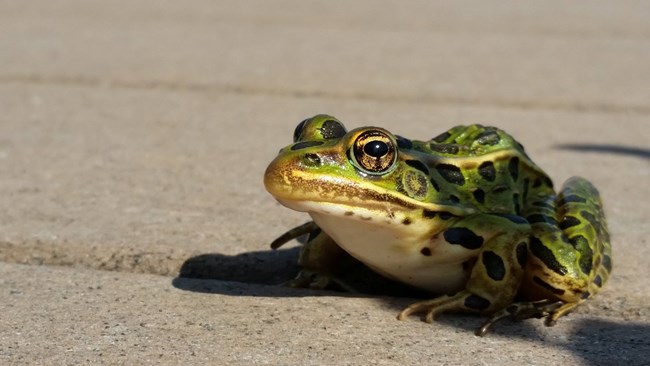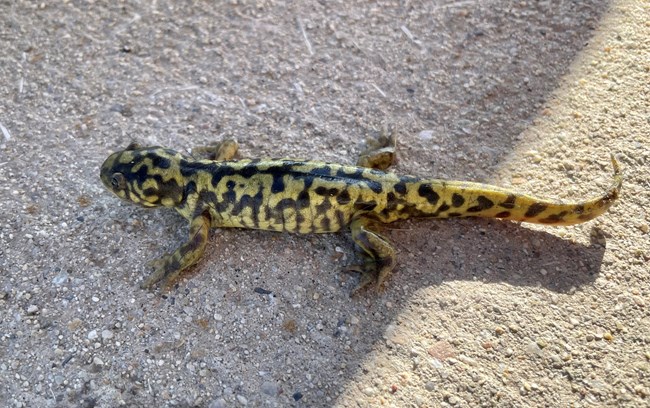|
Only three species of amphibians are found in the park. Two fossil amphibians can be seen at the visitor center.

USFWS / Kate Goodwin Northern Leopard Frog (Lithobates pipiens)These frogs are distinctive for their coloration: bold green with brown to black spots. It is from these spots that the leopard frog gets its name. Their range has been declining across the United States. Chytrid fungus, climate change, habitat loss, pesticide use, and introduction of non-native, predatory species are all thought to be contributors to its decline. It is considered a Species of Greatest Conservation Need (SGCN) by the Wyoming Game and Fish Department (WGFD). Boreal Chorus Frog (Pseudacris triseriata maculata)This frog ranges from Canada down into Arizona and New Mexico. Their common name, chorus frog, refers to their calling behavior. Males produce a series of single notes, whistles, or trills. Their calls can be heard from 1312 feet away. Adults are freeze tolerant and are believed to survive the winter in underground rodent burrows, under thick debris, or in crevices of rocks. They tend to stay near water, but they have been found up to 1640 feet away from the nearest source. In the park, they are most abundant in open grasslands but are also found in the aspen groves. 
Gaetano Palazzo Tiger Salamander (Ambystoma mavortium)The tiger salamander can reach over twelve inches in length. Like all amphibians, they prefer moist environments. They are born as aquatic larvae with external gills before metamorphosis transforms them into vibrantly colored adults. Most of their time in the summer is spent underground in burrows to avoid the heat. It is the only species of salamander found in Wyoming. It is considered a SGCN by the Wyoming Game and Fish Department WGFD. It is the Wyoming State Amphibian.References"Boreal Chorus Frog - Pseudacris maculata." Montana Field Guide. Montana Natural Heritage Program and Montana Fish, Wildlife and Parks. Accessed on February 24, 2024. https://fieldguide.mt.gov/speciesDetail.aspx?elcode=AAABC05130Ethier, J.P., Fayard, A., Soroye, P. et al. Life history traits and reproductive ecology of North American chorus frogs of the genus Pseudacris (Hylidae). Front Zool 18, 40 (2021). https://doi.org/10.1186/s12983-021-00425-w Jones, Don, Zach Wallace, Katrina Cook, and Ian Abernethy. "Wyoming BLM Amphibian Survey Project." Wyoming Natural Diversity Database. December 30, 2021. https://www.uwyo.edu/wyndd/_files/docs/reports/WYNDDReports/21jon01.pdf "Northern Leopard Frog - Lithobates pipiens." Montana Field Guide. Montana Natural Heritage Program and Montana Fish, Wildlife and Parks. Accessed on February 29, 2024. https://fieldguide.mt.gov/speciesDetail.aspx?elcode=AAABH01170 Wyoming Natural Diversity Database, University of Wyoming. "Western Tiger Salamander - Ambystoma mavortium." Wyoming Field Guide. Retrieved on 2/29/2024. https://fieldguide.wyndd.org/?species=ambystoma%20mavortium "Wyoming Species of Greatest Conservation Need." Wyoming State Wildlife Action Plan - 2017. Wyoming Game and Fish Department. Accessed on February 29, 2024. https://wgfd.wyo.gov/WGFD/media/content/PDF/Habitat/SWAP/SGCN-Introduction.pdf |
Last updated: April 29, 2025
